
Chapter 1 chemical reactions and equations || science || class 10
- 1. Chapter-1 Chemical Reactions and Equations By Nishit Gajjar
- 2. Content. 1.WhatAre Chemical Reaction 2.How do we identify a Chemical Reaction 3.Writing a chemical Reaction 4.Balancing a Chemical Reaction 5.Types Of Chemical Reaction. 6.Combination Reaction. 7. Decomposition reaction. 8.Displacement Reaction.
- 3. What Are Chemical Reactions? • Chemical Reaction: The transformation of chemical substance into another chemical substance is known as Chemical Reaction. For example: Rusting of iron, the setting of milk into curd, digestion of food, respiration, etc. • In a chemical reaction, a new substance is formed which is completely different in properties from the original substance, so in a chemical reaction, a chemical change takes place. Only a rearrangement of atoms takes place in a chemical reaction. • The substances which take part in a chemical reaction are called reactants. • The new substances produced as a result of a chemical reaction are called products.
- 4. How do we identify a Chemical Reaction • A Chemical Reactions is identified by any of these 4 factors • Change in state. 1.Change in color 2. Evolution of a gas. 3.Change in temperature. • According to law of conservation of mass matter can neither be created not be destroyed in a chemical reaction.
- 5. Writing a Chemical Reactions. • A chemical equation represents a chemical reaction. If you recall formulae of magnesium , oxygen and magnesium oxide, the above word-equation can be written as- Mg+O2 MgO
- 6. Balancing a Chemical Reaction. • To balance a chemical equation, first draw boxes around each formula. Do not change anything inside the boxes while balancing the equation. • List the number of atoms of different elements present in the unbalanced equation. • Start Balancing with the compound that contains the maximum number of atoms. It may be reactant or a product. In that compound, select the element which has the maximum number of atoms. • Balance the unbalanced atom. • Finally, to check the correctness of the balanced equation, we count atoms of each element on both sides of the equation.
- 7. • To make a chemical equation more informative, the physical states of the reactants and products are mentioned along with their chemical formula. The gaseous, liquid aqueous and solid state of the reactants and products are represented by notations (g), (l), (aq) and (s) respectively. • The word aqueous (aq) is written if the reactants or product is present as a solution in water.
- 8. Types Of Chemical Reactions. • There are 5 types of chemical reactions:- 1. Combination Reaction. 2. Decomposition Reaction. 3. Displacement Reaction. 4. Double Displacement Reaction. 5. Oxidation and Reduction(Redox Reaction).
- 9. Combination Reactions. • Reactions in which two or more reactants combine to form one product are called Combination Reactions. • Calcium oxide reacts vigorously with water to produce slaked lime realizing a large amount of heat. • Calcium hydroxide reacts slowly with carbon dioxide in air to form a thin layer of calcium carbonate on the walls. • It is Interesting to note that the chemical formula for marble is also CaCO3
- 10. Decomposition Reactions. • Reactions in which one compound decomposes in two or more compounds or elements are known as Decomposition Reaction. A decomposition reaction is just the opposite of combination reaction. • Decomposition of calcium carbonate to calcium oxide and carbon dioxide on heating is an important decomposition reaction used in various industries. Calcium oxide is called lime or quick lime.
- 11. Displacement Reactions. • When a element displaces another element from its respective compound of lower reactivity it is said to be a displacement reaction.
- 12. Double Displacement Reactions. • Reactions in which there is an exchange of ions between the reactants are called double displacement reactions. • These reactions are also called precipitation reactions as an insoluble substance is formed which is known as a precipitate. Any reaction that produces a precipitate can be called a precipitation reaction.
- 13. Oxidation and Reduction(Redox Reaction) • If a substance gains oxygen during reaction, it is said to be oxidized. If a substance loses oxygen during a reaction, it is said to reduced. • If one reactants gest oxidized while the other gets reduced. • If a substance gains oxygen or loses hydrogen durinf reaction, it is oxidized.
- 14. Corrosion. • Corrosion is defined as the process in which metal with atmospheric moisture and chemicals resulting in the formation of rust. • It is a process where metals are attacked by moisture, acids etc. Some daily examples of corrosion that you may have observed are the black coating that develops on articles made of silver or the green coating on copper articles. Corrosion that occurs on materials made of iron is ‘rusting‘.
- 15. Rancidity. • The term ‘rancidity’ refers to a condition in which food has become undesirable. • It is often used to describe the oxygen content of oils. It’s a term used to describe the oxygen damage in food. • When oxygen molecules interact with the oil and food, the normal structure of the food is damaged, resulting in a change in odour and taste, and it is not recommended for consumption. • An example of rancidity is when a chips pack is exposed to atmospheric air which results in a change in taste and odour.
